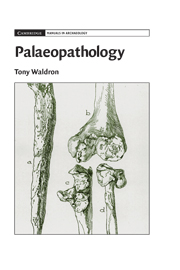Book contents
- Frontmatter
- Contents
- List of Figures
- Preface
- 1 Introduction and Diagnosis
- 2 Bone Metabolism and Pathology
- 3 Diseases of Joints, Part 1
- 4 Diseases of Joints, Part 2
- 5 Bone forming and DISH
- 6 Infectious Diseases
- 7 Metabolic Diseases
- 8 Trauma
- 9 Tumours
- 10 Disorders of Growth and Development
- 11 Soft Tissue Diseases
- 12 Dental Disease
- 13 An Introduction to Epidemiology
- Select Bibliography
- Index
- References
9 - Tumours
Published online by Cambridge University Press: 05 June 2012
- Frontmatter
- Contents
- List of Figures
- Preface
- 1 Introduction and Diagnosis
- 2 Bone Metabolism and Pathology
- 3 Diseases of Joints, Part 1
- 4 Diseases of Joints, Part 2
- 5 Bone forming and DISH
- 6 Infectious Diseases
- 7 Metabolic Diseases
- 8 Trauma
- 9 Tumours
- 10 Disorders of Growth and Development
- 11 Soft Tissue Diseases
- 12 Dental Disease
- 13 An Introduction to Epidemiology
- Select Bibliography
- Index
- References
Summary
Although the word tumour simply means a swelling, in the minds of most people it has unpleasant connotations as it is frequently taken as a synonym for cancer, which it is not. Without any further elaboration, a tumour is simply a new growth and on this account it is sometimes also known as a neoplasm, and the process by which it arises, as neoplasia. Tumours may be classified as either primary or secondary, or as either benign or malignant. A primary tumour is one that originates in the tissue in which it is found, whereas a secondary tumour is one that has arisen in a different tissue from that in which it is found. A benign tumour does not spread beyond the tissue in which it originates. By contrast, the characteristic of a malignant tumour is that it does spread beyond its tissue of origin. Malignant tumours are often a cause of death whereas this is generally not the case with benign tumours, although there are exceptions as we shall see. A secondary tumour is malignant by definition, but a primary tumour may be either benign or malignant.
EPIDEMIOLOGY OF BONE TUMOURS
Primary bone tumours are uncommon and benign tumours are much more common than malignant. Malignant primary tumours of bone account for less than 1% of all malignant tumours and are more common in males than in females except in late childhood when there is a very slight female excess. The male excess becomes increasingly apparent with increasing age.
- Type
- Chapter
- Information
- Palaeopathology , pp. 168 - 190Publisher: Cambridge University PressPrint publication year: 2008

